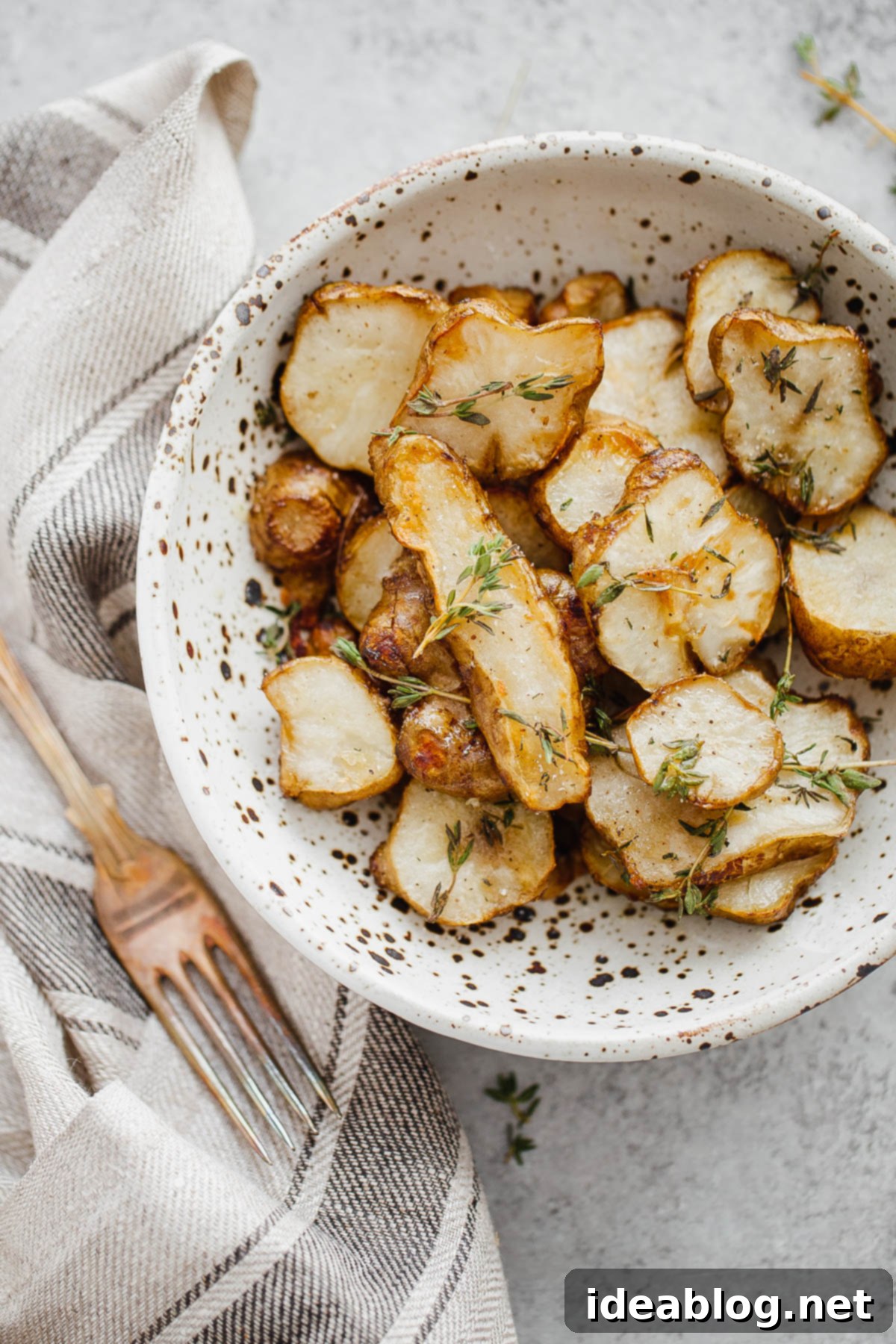Perfectly Roasted Sunchokes: Your Guide to Easy, Flavorful Jerusalem Artichokes
Roasted Sunchokes are a delightful and healthy vegetable side dish, perfect for fall and winter meals. Sliced and simply tossed with olive oil, salt, and pepper, they roast until beautifully caramelized and tender, offering a unique nutty and sweet flavor.
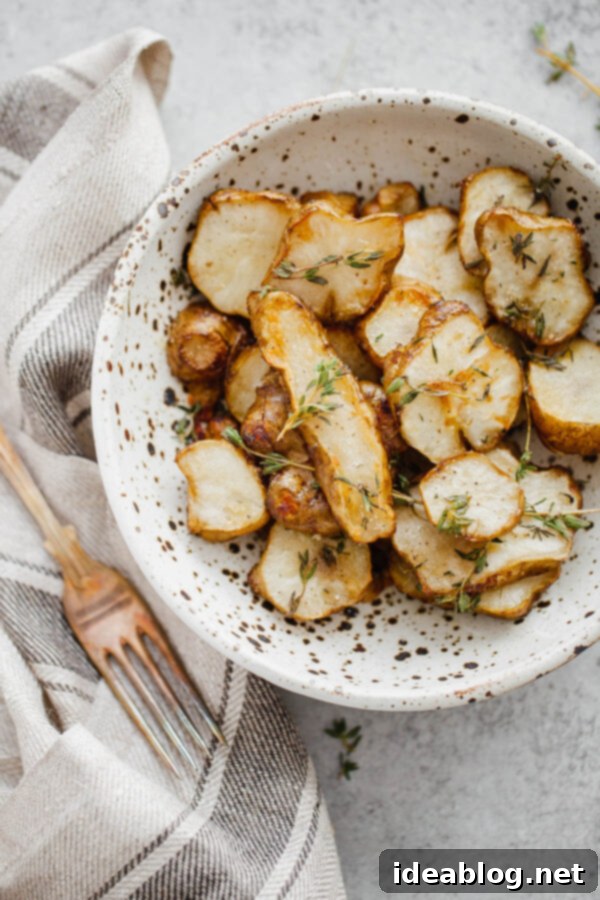
Discover the Magic of Roasted Sunchokes (Jerusalem Artichokes)
My culinary journey with sunchokes, also known as Jerusalem artichokes, began in a truly unforgettable way. I was visiting my parents in scenic Scotland about seven years ago. We dined at an exquisite restaurant where my mom and I savored an incredible sunchoke soup, rich with pancetta and generously topped with fresh black truffles. It was, without exaggeration, one of the most remarkable soups I’ve ever tasted, leaving a lasting impression of this unique root vegetable.
Several years later, my path crossed with sunchokes again while working as a line cook in Washington, D.C. In our bustling restaurant kitchen, we would meticulously slice sunchokes paper-thin using a mandolin. These delicate slices were then plunged into a hot fryer, transforming into unbelievably light and crispy sunchoke chips—utterly addictive and a testament to their versatility.
Having recently come across a fresh bag of sunchokes during their peak season, which spans from late fall to early spring, I was inspired to delve deeper into this somewhat underappreciated and often misunderstood root vegetable. It felt like the perfect opportunity to share this incredibly simple, yet profoundly delicious, roasted sunchokes recipe with you.
Whether you’re a seasoned chef or a curious home cook who has always wondered how to prepare or cook sunchokes, this back-to-basics guide and easy recipe are crafted just for you. Get ready to unlock the potential of these delicious tubers!
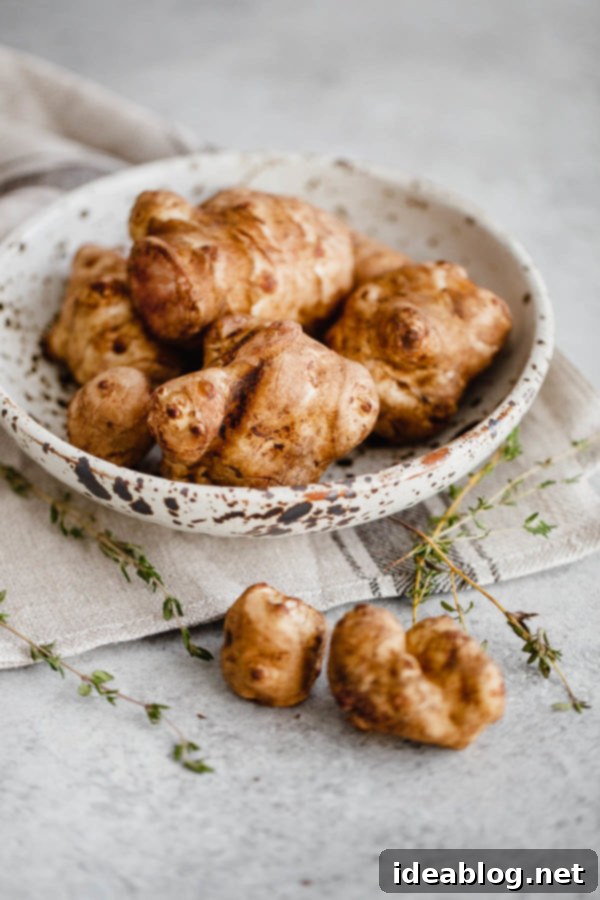
Back to Basics: Understanding Sunchokes
A significant part of the confusion and mystery surrounding sunchokes stems from their common alias: “Jerusalem artichokes.” This name is quite misleading, as these delightful tubers are neither from Jerusalem nor are they related to the true artichoke family. The truth is far more intriguing: sunchokes are actually the tuberous roots of a type of sunflower plant, Helianthus tuberosus. This botanical fact often surprises many, highlighting their unique place in the vegetable kingdom.
Sunchokes boast a distinctive appearance, varying in size and color, from pale brown (as pictured above) to shades of light red or purple. Their knobbly, irregular shape often causes them to be mistaken for fresh ginger root at first glance. While they are often prepared in ways similar to potatoes—boiled, mashed, or roasted—sunchokes possess a uniquely crunchy texture when raw. This crispness is reminiscent of a radish or turnip, making them surprisingly versatile for salads or slaws (yes, you can absolutely eat them raw!).
Beyond their intriguing flavor and texture, nutritionally speaking, sunchokes are incredibly beneficial. They are remarkably high in essential minerals such as iron and potassium, vital for energy and electrolyte balance. Furthermore, sunchokes are an excellent source of indigestible fiber, particularly a prebiotic known as inulin. This specific type of fiber is known to promote gut health by feeding beneficial bacteria in the digestive system, contributing to overall well-being. Additionally, they offer a wonderful low-carb and lower-calorie alternative to traditional potatoes or other higher-carb root vegetables, making them a fantastic choice for those monitoring their carbohydrate intake.
How to Select and Store Sunchokes for Optimal Freshness:
When selecting sunchokes, look for tubers that are firm to the touch, with no soft spots, blemishes, or signs of sprouting. As mentioned, their colors can range from a light, earthy brown to a slightly reddish or purplish hue. For roasting, larger sunchokes with fewer knobs are generally preferred, as they are much easier to clean, slice uniformly, and prepare. Uniform slices ensure even cooking and caramelization, leading to the best texture and flavor.
To store sunchokes properly, place them in a plastic bag or a breathable cloth bag. Store them in the crisper drawer of your refrigerator, where they can maintain their freshness for up to two weeks. Avoid washing them until you are ready to use them, as excess moisture can accelerate spoilage.
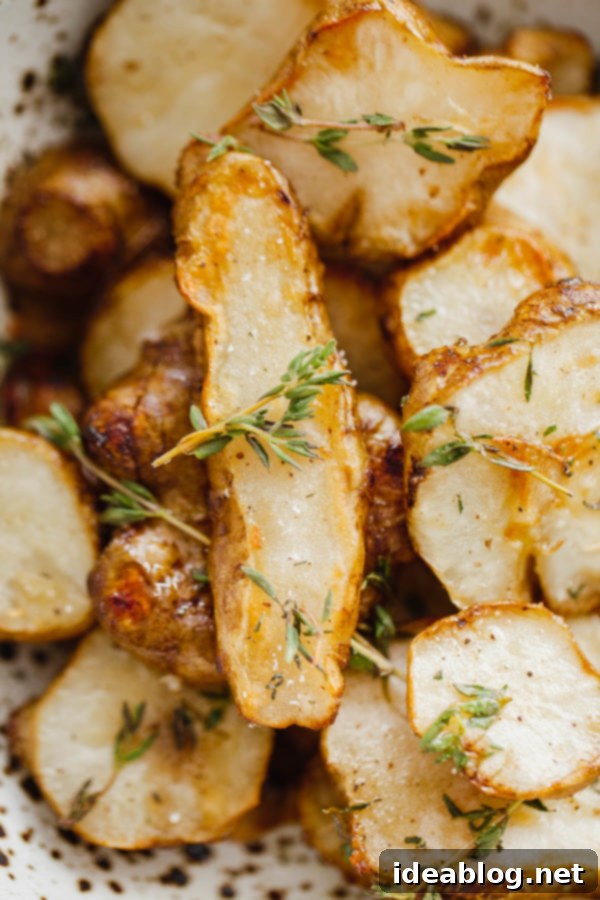
Mastering the Art of Cooking Sunchokes: A Versatile Root Vegetable
Sunchokes are remarkably versatile in the kitchen and can be enjoyed in a myriad of ways. They can be served raw in salads, crisped up by frying, pureed into creamy soups, gently steamed, or, as in this recipe, roasted to tender perfection. One important characteristic to note is their tendency to oxidize, or brown, quickly once sliced, much like celery root or apples. To prevent this, it’s best to use them immediately after slicing. If you need to prepare them in advance, store the sliced sunchokes in acidulated water (water with a squeeze of lemon juice) to maintain their pristine color.
When it comes to roasting sunchokes, I often prefer to leave the skin on. Not only does this save preparation time, but the skin becomes delightfully crisp and flavorful during roasting. However, if you plan to serve sunchokes raw, such as in a salad, peeling them is recommended for a smoother texture. If peeling, try to choose larger, less knobby sunchokes, as their irregular shape can make peeling a challenging task otherwise!
For this simple yet exquisite roasting method, begin by slicing your sunchokes into roughly 1/2-inch thick pieces. This thickness allows for a good balance of tender interior and caramelized exterior. Toss them thoroughly with a generous drizzle of good quality olive oil, along with a sprinkle of salt and freshly ground black pepper. Roast them at a relatively high temperature, around 425°F (220°C), for approximately 20 minutes, flipping them halfway through. This high heat promotes excellent caramelization, resulting in a sweet, nutty crust. Alternatively, for a slightly different texture, you can slow roast them at 325-350°F (160-175°C) for a longer period until tender. Just before serving, elevate their flavor by tossing the roasted sunchokes with fresh herbs like finely chopped thyme or rosemary, or simply enjoy them as they are for a pure, earthy taste.
Important Dietary Note: Sunchokes are a significant source of inulin, a type of dietary fiber. While inulin is a beneficial prebiotic that supports gut health, it can cause stomach discomfort, gas, or bloating for some individuals, especially if consumed in large quantities or by those with sensitive digestive systems. If you are new to sunchokes or concerned about digestive reactions, I highly recommend two precautions: first, remove most of the peel prior to roasting, as some of the inulin is concentrated there; and second, start with a smaller serving size to gauge your body’s reaction. Listen to your body and adjust accordingly to enjoy this wonderful vegetable comfortably.
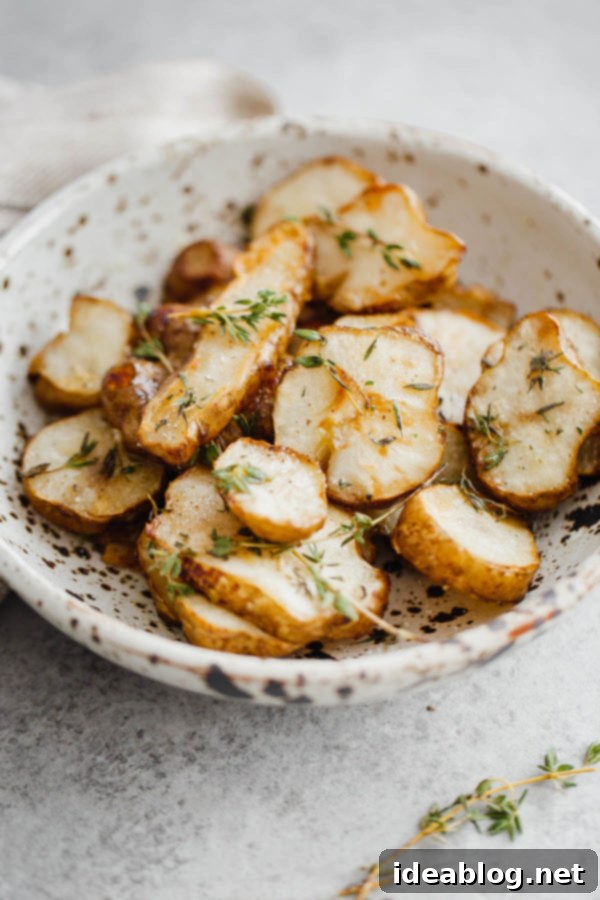
Once cooked or roasted, sunchokes transform, offering a truly unique culinary experience. Their flavor profile is wonderfully complex, characterized by an intense nuttiness, a hint of earthy sweetness, and sometimes a subtle undertone reminiscent of artichoke hearts. The texture, once roasted, becomes incredibly creamy and tender, often compared to that of a perfectly cooked potato, similar to these roasted fingerling potatoes. This combination of rich flavor and satisfying texture makes them a standout vegetable.
These delicious tubers are definitely worth seeking out, especially during the cooler fall and winter months when they are most readily available and at their peak freshness. They offer a fantastic way to add variety and exceptional flavor to your seasonal meals.
Other Creative Ways to Prepare Sunchokes:
- Sunchoke Soup with Crispy Sage Leaves: A warm and comforting dish, perfect for showcasing their creamy texture and delicate flavor.
- Fennel, Sunchoke, and Apple Salad: Highlights their raw crunch and subtle sweetness in a refreshing, crisp salad.
- Fried Sunchoke Chips: An irresistible snack or garnish, turning thin slices into airy, savory crisps.

Roasted Sunchokes
Pin Recipe
Leave a Review
Save RecipeSaved!
Important Note: Sunchokes contain inulin, a type of fiber that can cause digestive discomfort for some individuals, particularly if eaten in large quantities. For those new to sunchokes or with sensitive stomachs, it’s advisable to remove most of the peel before roasting and to begin with a smaller serving size.
Ingredients
- 1 lb sunchokes (Jerusalem artichokes) *see recipe notes thoroughly rinsed, scrubbed, and cut into uniform ½-inch thick slices
- 1½ tablespoons extra virgin olive oil plus an additional drizzle for serving, if desired
- ½ teaspoon kosher salt
- freshly ground black pepper
- 1-2 sprigs fresh thyme finely chopped, or fresh rosemary
Instructions
-
A Quick Note on Inulin: Sunchokes are rich in inulin, which can cause digestive upset for some individuals, especially in larger quantities. If you are uncertain or have a sensitive stomach, consider removing most of the peel prior to roasting and start with a smaller portion to assess your tolerance.
-
Preheat your oven to 425°F (220°C). Position an oven rack in the center of the oven. In a spacious medium bowl, combine the prepared sunchoke slices with the olive oil, kosher salt, and freshly ground black pepper. Toss everything thoroughly until all the sunchoke pieces are evenly coated. Spread the seasoned sunchokes in a single, even layer on a half sheet pan, ensuring that each piece has a little space around it. This crucial step promotes proper air circulation, allowing the sunchokes to caramelize beautifully rather than steam.
-
Roast the sunchokes for 18 to 22 minutes. Make sure to flip the pieces halfway through the cooking time to encourage even browning and caramelization on both sides. Continue roasting until the sunchokes are lightly golden-brown, tender when pierced with a fork, and have developed a delicious nutty aroma.
-
Once roasted to perfection, gently transfer the sunchokes to a serving dish. Toss them with the freshly chopped thyme leaves (or rosemary) and, if needed, a light sprinkle of additional kosher salt to taste. For an extra touch of richness and flavor, you can drizzle them lightly with a bit more extra virgin olive oil just before serving, though this is entirely optional. Serve these delightful roasted sunchokes immediately to enjoy their optimal texture and taste.
Tips For Success:
- Sunchokes come in a variety of natural shades, from light brown to a slightly reddish-purple. Always select firm tubers that show no signs of soft spots or wrinkles. For easier preparation and more uniform slices, which are ideal for roasting, opt for larger sunchokes with fewer irregular knobs.
- To maintain their freshness and extend their shelf life, store sunchokes unwashed in a plastic bag within the vegetable drawer of your refrigerator. When stored correctly, they should remain fresh and ready to use for approximately 2 weeks.
- Consider adding other seasonings like a pinch of garlic powder, onion powder, or smoked paprika along with the salt and pepper before roasting for an extra layer of flavor.
- For a touch of brightness, a squeeze of fresh lemon juice over the roasted sunchokes just before serving can truly elevate their taste.
